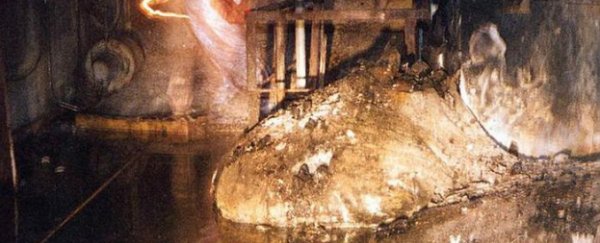A team of researchers in the US has performed a world-first experiment that will help them work out how uranium dioxide fuel behaves in its molten state - something that generally only occurs at the start of a nuclear meltdown.
This is the first time scientists have managed to get an up-close view of what happens to the fuel as it heats up to more than 3,000 degrees Celsius. Their results have been published in Science, and will help researchers improve safety at nuclear power plants.
"In extreme events like Fukushima and Chernobyl, the uranium dioxide literally melts, and we wanted to study the material to really understand it," the paper's lead author Lawrie Skinner from Stony Brook University in New York told Stuart Gary from ABC Science.
"We can now pin down a little bit more accurately what the properties and temperature of the melt will be. Any sensible reactor design should take into account the real structure, physical properties, and behaviour of this melt."
The reason it's taken so long for scientists to study this phenomenon is that it's extremely tough to find a furnace that can withstand heats of 3,000 degrees Celsius - most will begin to melt and react with the uranium at such a high temperature, which interferes with the results. (Well, that, and the fact that generally people want to be as far away from a nuclear reactor as possible.)
To avoid the melting furnace issue, Skinner and his team got rid of the container altogether and experimented on a tiny 3-millimetre bead of uranium dioxide floating in a gas stream.
To team then heated the uranium to melting point with a laser, and studied the arrangement of the uranium and oxygen atoms in both solid and liquid states using high energy synchrotron X-ray diffraction.
They found that when uranium dioxide melts, the arrangement of the oxygen around each uranium atom changes drastically.
"The average number of oxygens surrounding each uranium atom is reduced quite dramatically, affecting physical properties like viscosity and diffusion of the atoms at these extreme conditions," Skinner told Gary at ABC Science.
"In uranium dioxide each uranium is surrounded by eight oxygen in little cubes, and many of these little cubes connect together to form the crystal structure. However in the molten state, there's a mixture of six and seven oxygen around each uranium atom."
Of course, melting uranium is only the first step of a nuclear meltdown, but it's also the highest temperature stage of the reaction.
In real meltdowns, such as the one that occured at Chernobyl and Fukushima, this molten uranium dioxide reacts with the zirconium metal cladding on the fuel rods, as well as the steel and concrete structure of the power plant. Scientists called this melted product corium (and it's pictured above).
As Gary writes for ABC Science: "These corium lavas are often referred to as Medusa because it would be fatal to be close enough to see them."
The next step is for the researchers to measure how more complicated compounds, such as uranium zirconium oxide, behave at extremely high temperatures. And in the future they're hoping they can find some clues as to how to protect people from the effects of nuclear meltdowns.
They might also become the only people to see the Medusa-like corium lava in real life and live to tell the tale, which is pretty amazing.
Source: ABC Science
